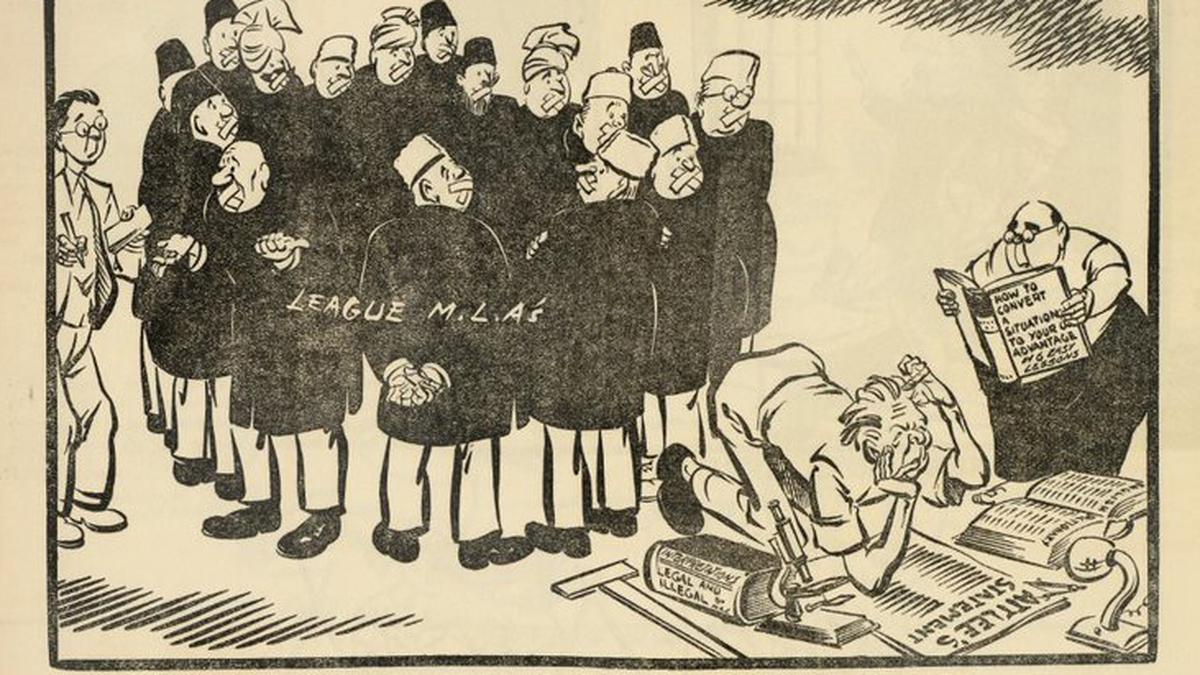
An exhibition of cartoons by ever-green Enver Ahmed
The Hindu
On Saturday, Dr. Ramachandra Guha inaugurated the exhibition, Enver Ahmed, presented by the Indian Institute of Cartoonists. It was followed by an introductory lecture by Dr. Ritu Gairola Khanduri the curator of the exhibition.
Historian Dr. Ramachandra Guha on Saturday inaugurated the exhibition of the late Enver Ahmed, well-known Indian cartoonist, at the Indian Institute of Cartoonists (IIC). It was followed by an introductory lecture by Dr. Ritu Gairola Khanduri, the curator of the exhibition.
Enver Ahmed’s (1909-1992) was a political cartoonist who worked for nearly three decades across three prominent newspapers in India (then undivided). His career extended from the colonial era to the post-Independence years. “His political cartoons provide a significant testament to the history of the subcontinent. Ahmed’s brushstrokes reveal the political concerns, metaphors, and gibes of those years. Like the giants in the field, David Low and Shankar, Ahmed inspired a generation of cartoonists,” said a release from IIC.
“However, Ahmed also stood apart, and ahead of his time, by expressing, through bold lines and brilliant caricatures, his heartfelt anguish at the political violence amidst which the nation-states of India, Pakistan, and Bangladesh were born, and which to some extent they perpetuated,” said IIC. His pamphlet titled “Anatomy of a Betrayal” was particularly notable in the way in which it addressed cycles of violence. “Unyielding in his criticism of political systems which neglected human rights, and which were driven only by remorseless profits, Ahmed’s cartoons strike a sombre chord, capturing the harsh reality of the subcontinent and the global forces that shaped its destiny.”
Reflecting on the influence of cartoonists in the political landscape back then, IIC said, “Cartoons provided sharp political insight and effective public communication. As a result, cartoonists like Enver Ahmed can still serve us as our chroniclers, and as commentators on our past. If their works are displayed more often, as at this exhibition, they will provide future generations with an enduring, enjoyable, and sharp lens to perceive the past.”
Through this exhibition, based on her research, Dr. Ritu Gairola Khanduri, the author of “Caricaturing Culture in India” (published by Cambridge University Press), pays homage to Enver Ahmed, said the release.
The exhibition is taking place at Indian Cartoon Gallery, Bengaluru, and will continue from July 22 to August 5, except on Sundays.

“Writing, in general, is a very solitary process,” says Yauvanika Chopra, Associate Director at The New India Foundation (NIF), which, earlier this year, announced the 12th edition of its NIF Book Fellowships for research and scholarship about Indian history after Independence. While authors, in general, are built for it, it can still get very lonely, says Chopra, pointing out that the fellowship’s community support is as valuable as the monetary benefits it offers. “There is a solid community of NIF fellows, trustees, language experts, jury members, all of whom are incredibly competent,” she says. “They really help make authors feel supported from manuscript to publication, so you never feel like you’re struggling through isolation.”

Several principals of government and private schools in Delhi on Tuesday said the Directorate of Education (DoE) circular from a day earlier, directing schools to conduct classes in ‘hybrid’ mode, had caused confusion regarding day-to-day operations as they did not know how many students would return to school from Wednesday and how would teachers instruct in two modes — online and in person — at once. The DoE circular on Monday had also stated that the option to “exercise online mode of education, wherever available, shall vest with the students and their guardians”. Several schoolteachers also expressed confusion regarding the DoE order. A government schoolteacher said he was unsure of how to cope with the resumption of physical classes, given that the order directing government offices to ensure that 50% of the employees work from home is still in place. On Monday, the Commission for Air Quality Management in the National Capital Region and Adjoining Areas (CAQM) had, on the orders of the Supreme Court, directed schools in Delhi-NCR to shift classes to the hybrid mode, following which the DoE had issued the circular. The court had urged the Centre’s pollution watchdog to consider restarting physical classes due to many students missing out on the mid-day meals and lacking the necessary means to attend classes online. The CAQM had, on November 20, asked schools in Delhi-NCR to shift to the online mode of teaching.









